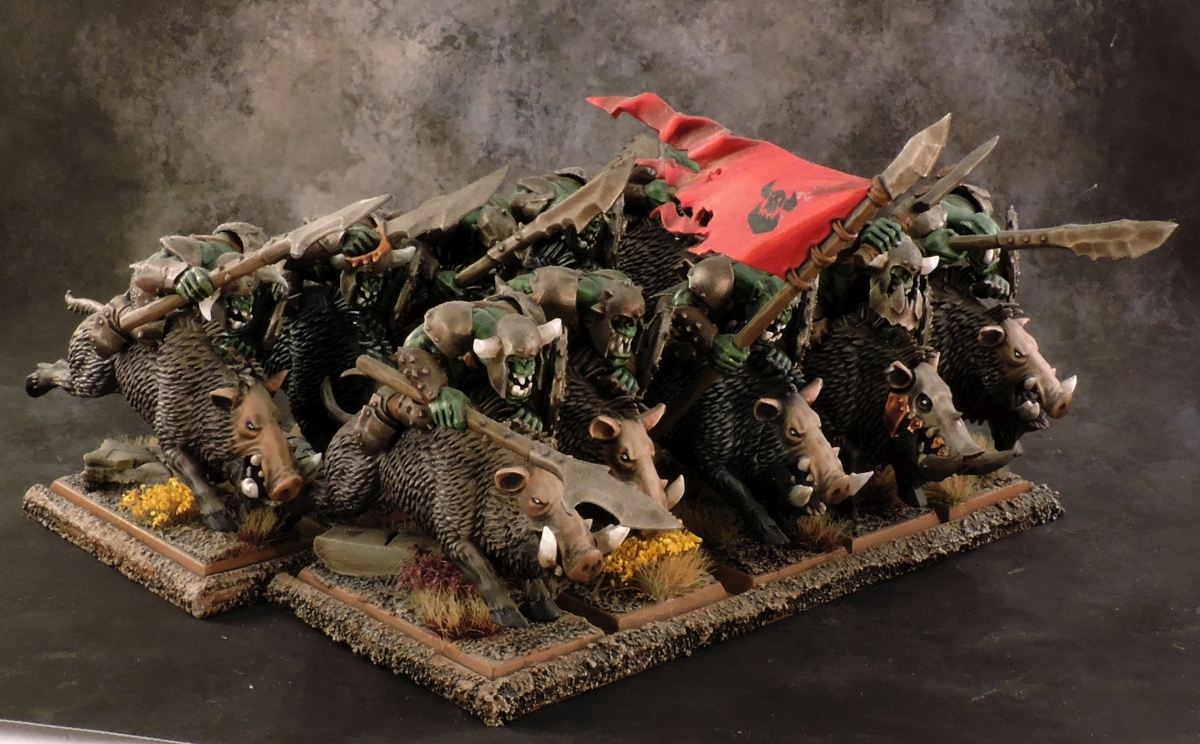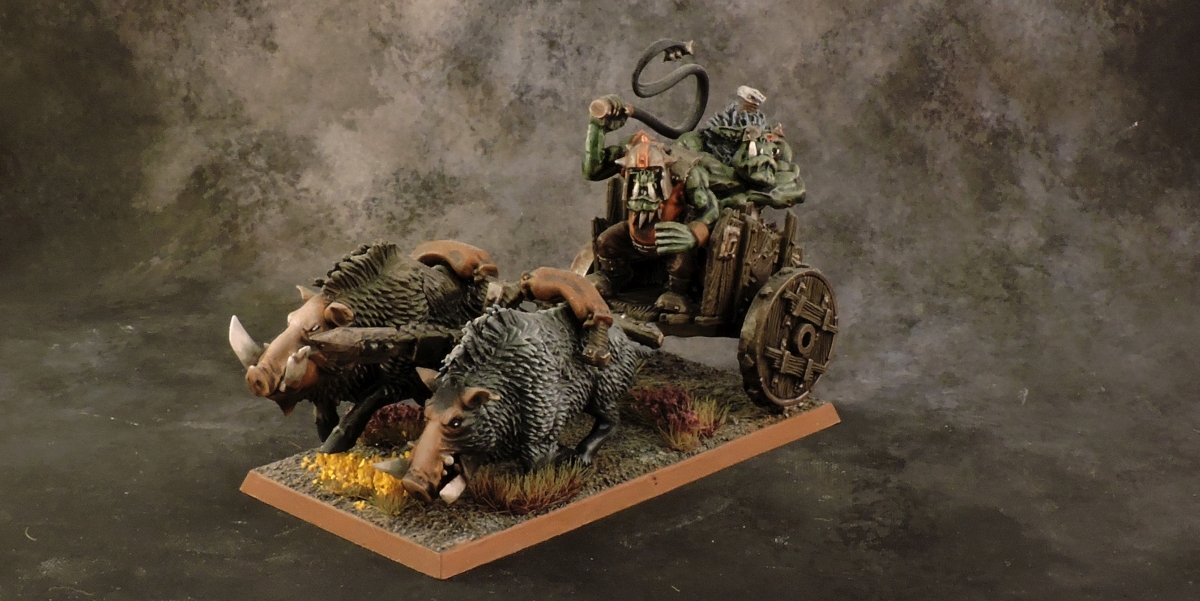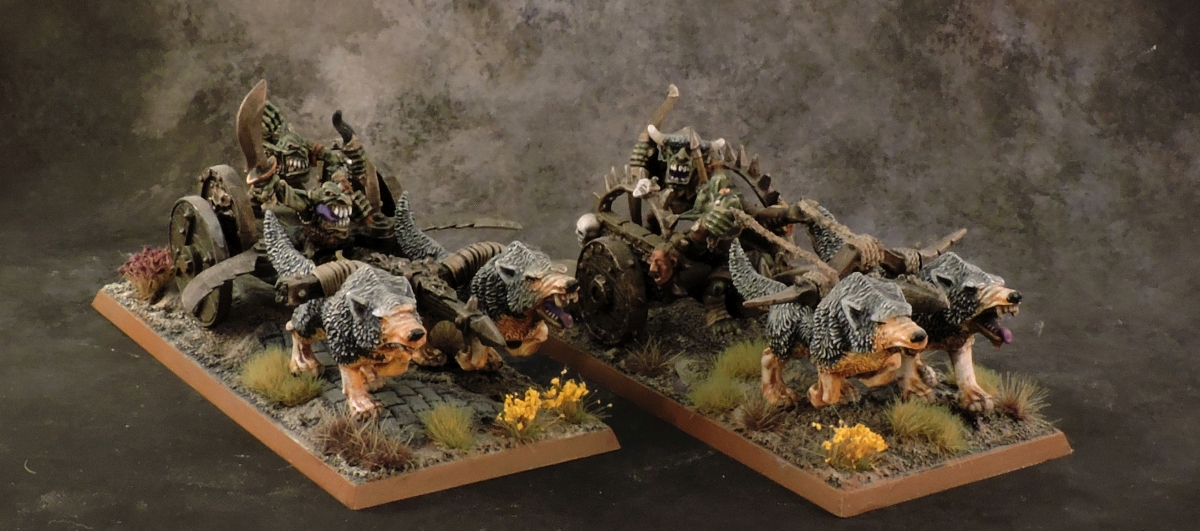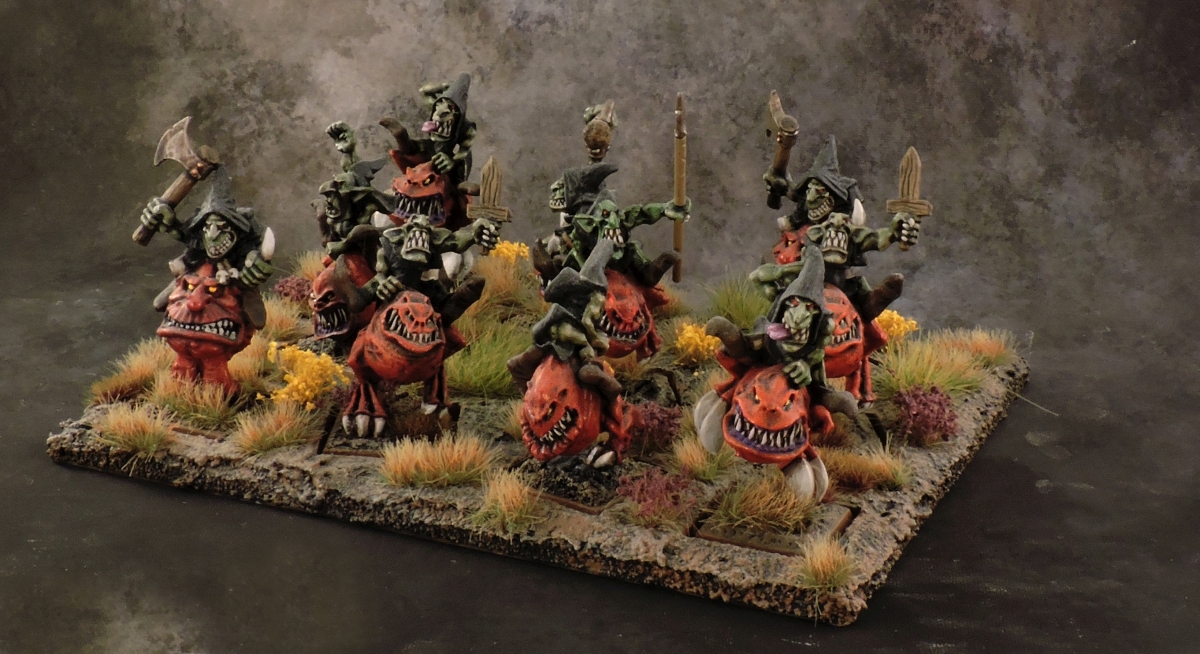Orcs and Goblins were my very first Warhammer army and thus first miniatures. The ancient Grenadier and Games Workshop models – in glorious enamel paints – are still in my collection but no longer suitable for the table top. As replacement, I decided to build a new “modern” Orc and Goblin army shortly before the collapse of the Warhammer World. As usual, my goal was to get “one of everything in the book” which in this case is quite a bit.
Orc and Goblin armies are incredibly diverse so it is important to create unifying elements for a cohesive look for the army. In my case, I used a consistent scheme for the green skin: Gretchin Green followed by a very wet overbrush of Bleached Bone and an Agrax Earthshade wash. Goblins then get one wash of Biel-Tan Green, Orcs two coats and Black Orcs three coats. This gives a nice gradient of skin colours while being tone-consistent (and easy to paint over hundreds of models). The other unifying elements are blue/red accents and purple/yellow flowers on the basis. Combined, this ties everything together without disruption in the messy nature of the Orcs.
The horde is large enough that this page will cover them in groups by type rather than the usual unit class breakdown.
Orcs
Orcs are the baseline component of the horde. Nothing fancy, but bulk gets the job done. A lot of the models are based on multi-bases to allow for conversions and some mini-dioramas in the force. This style of basing suits the chaotic style of the Orc and Goblin army quite nicely in my opinion.
Legendary Leaders: The core element of regular Orcs is led by a mighty a host of heroes. Gorbad Ironclaw on a Warboar and Azhag the Slaughterer on Wyvern are our legendary characters. The latter is available in both versions from the 90’s and 00’s. Borgut Facebeater – now no longer all that legendary – rounds out the group (again in two versions).
Leaders: Conventional leadership is provided by an Orc Warboss on foot and one on a Warboar.

An Orc Big Boss with a Battle Standard provides critical morale boosts to the horde.
Magical support is provided by a Great Shaman.

Troops: Two mobs of Orc Boyz – one thirty, one twenty-five strong – provide the center of the Orc horde. The models are a mix of monopose and multi-part plastic kits with some conversions thrown in for variety. One unit has unit fillers with a mob fight and a cow being carried as a trophy. The other has a boar with barrels on its back.





I have a unit of 20 Orc Boyz with bows but just can’t bring myself to paint them…
Cavalry: A giant unit of 15 Orc Boar Boyz can punch through any opposition – or so they think – or at least provide a delivery mechanism for the mounted Warboss.


Support: Two Orc Boar Chariots offer some punching power to the Orc horde. The original boars were replaced with modern-style boars to fit in better with the rest of the army. The big orc can also be used as a chariot-mounted hero if needed (Forge World model).


Savage Orcs
Savage Orcs are the wild cousins of the regular Orcs. I went with some basic conversions but most of the models are stock. The Savage Orc kits are just really well done and need little work.
Leaders: Wurzag Da Great Green Prophet leads the Savage Orc contingent. He can be mounted on a Warboar as well (some conversion to get him to fit on a modern-style boar for consistency). Add a Big Boss and two regular Shamans to provide some casting variety.



Troops: A block of 25 Savage Orcs – carrying their sacred idol – adds one more solid core element to the horde. The second unit is old school metal with a paintjob dating back to the 1990s that I have tried to tie into this army’s style.


Cavalry: Ten Savage Orc Boar Boyz – as a single unit or two smaller units – provide a quick way to apply Frenzy where needed!

Black Orcs
Black Orcs are the elite of the Orc horde. I went with the classic red armour scheme for the entire Black Orc force which matches the accent colour of the other Orc units. I based all the Black Orcs senior characters on double-wide 25mm bases (not cavalry based which are marginally smaller – two 25mm bases glued together). They count as having an extra trooper next to them but this left room for conversion and makes the Black Orcs stand out.
Leaders: Grimgor Ironhide leads the mighty Black Orc contingent of the horde. Morglum Necksnapper – on old school mount – is also available if a mounted Black Orc leader is required. A full spread of Black Orc Warboss, Black Orc Big boss and Big Boss with Battle Standard are available to lead units and quell animosity.



Troops: A wide formation of thirty Black Orcs can stomp just about any enemy infantry formation into the mud. Classic models but many on multi-based to give them a bit of arm-spacing.

Goblins
Goblins are the weaker cousins of the Orcs but they make up for this in numbers. Like the regular Orcs, the normal Goblins might not be the most exciting force but they offer a lot of the key support elements for the horde.
Leaders: Grom the Paunch on his over-sized chariot leads the Goblin force. This is a stock model that I painted long before the current force so it doesn’t fit in perfectly. Good enough though for a very specialized character. Goblin heroes are cheap so there are lots of them. A Warboss, three Big Bosses on foot and two more on Giant Wolves.



Magical assistance comes from a Great Shaman.

Troops: Forty Goblins in a long bus formation make up the core of the Goblin contingent. They play host to three Nasty Skulkers in their ranks.


Cavalry: Two small units of Wolf Riders – one with spears and one with bows – provide the mobile scouting element.


Support: Three Wolf Chariots add punch to the horde. The left is the standard plastic kit while the right model is an ancient “ghost chariot” model that used to be a regiment or renown about 30 years ago (with “modern” wolves”). The third chariot, from the same “ghost chariot” kit, still has the original metal wolves (but a few other repaired parts that got lost over the decades).


Artillery support is provided by a Spear Chukka and Rock Lobber.


Forrest Goblins
Forrest Goblins used to be an independent unit but later army lists subsumed them into the regular Goblin list. The old models are too nice to be left out though, so I made a small contingent of Forrest Goblins.
Leaders: A Forrest Goblin Warboss and Big Boss ride two generations of Gigantic Spiders to war (the 90s version a bit less “gigantic”). A single Shaman adds a bit of wizardry (seen front right in the unit). I also made a simple proxy for Snagla Grobspit.

Troops: A big mob of forty Forrest Goblins brings along their own tree and some captured spiders. These are mostly classic metal models with a few conversions. The Goblins in the tree are old spider riders.

Cavalry: The Battle of Skull Pass set has provided me with lots and lots of plastic Spider Riders. Not very useful, but I painted them up nevertheless. Enough for a big mob and two smaller units in support.



Support: Two mighty Arachnarok Spiders – one with a platform on top – provide some of the toughest elements of the horde.
Night Goblins
The last Goblin variant are the famous Night Goblins. This is almost a range in itself and could be fielded as a stand-alone army for smaller battles up to 2500 points. I used the same accent red for the Squigs which ties this contingent into the main horde despite the distinct black robes.
Leaders: Skarsnik, Warlord of the Eight Peaks, with his mighty pet Gobbla is the quintessential Night Goblin Lord. The new model is gorgeous so the old version got dumped into my Mordheim Goblin Warband.

Night Goblin heroes are very cost-efficient and beautiful models so I painted up quite a few of them. A Night Goblin Warboss, two Big Bosses, a Big Boss with Battle Standard, and two Big Bosses riding Great Cave Squigs.




Night Goblin Shamans are also very useful so there are two of them (and some of the Skull Pass generic Big Bosses above can easily double as lower level shamans).

Troops: Three big blocks of forty Night Goblins provide plenty of staying power to the horde. Two with spears and one with bows. Each unit has Netters and two embedded Fanatics. The models are mostly from the Battle of Skull Pass set with one box of multi-part models thrown in for diversity (and some metal netters).





A giant herd of 40 Squigs and herders is one of the scariest sights one can see on the battlefield. The models are a mix from all editions with even an old Gobbla thrown in.

Cavalry: A group of 10 Squig Hoppers make up the pseudo-cavalry element of the force.

Support: Night Goblins have some terrifying monsters at their disposal. A pair of Mangler Squigs can wreck havoc on enemy formations.


A Colossal Squig – from Forge World – offers a Giant proxy since its own rules are a bit sad for such a large model.


The Squig Gobba is another Forge World model that I use mostly as a Rock Lobber proxy.


Finally, a Doom Diver provides “precision” artillery support.

Followers
Beyond Orcs and Goblins, a variety of other creatures follows the horde. Three mighty Giants can crush any resistance. They are the current plastic kit, the old school metal kit and a very old Grenadier model carrying a fighting platform.
One step down in the size scale are Trolls which come in Stone Troll and River Troll flavour.
Last, and definitely least, are a horde of Snotlings and their two Pump Wagons. While largely useless in battle, these models are just too characterful to ignore.

